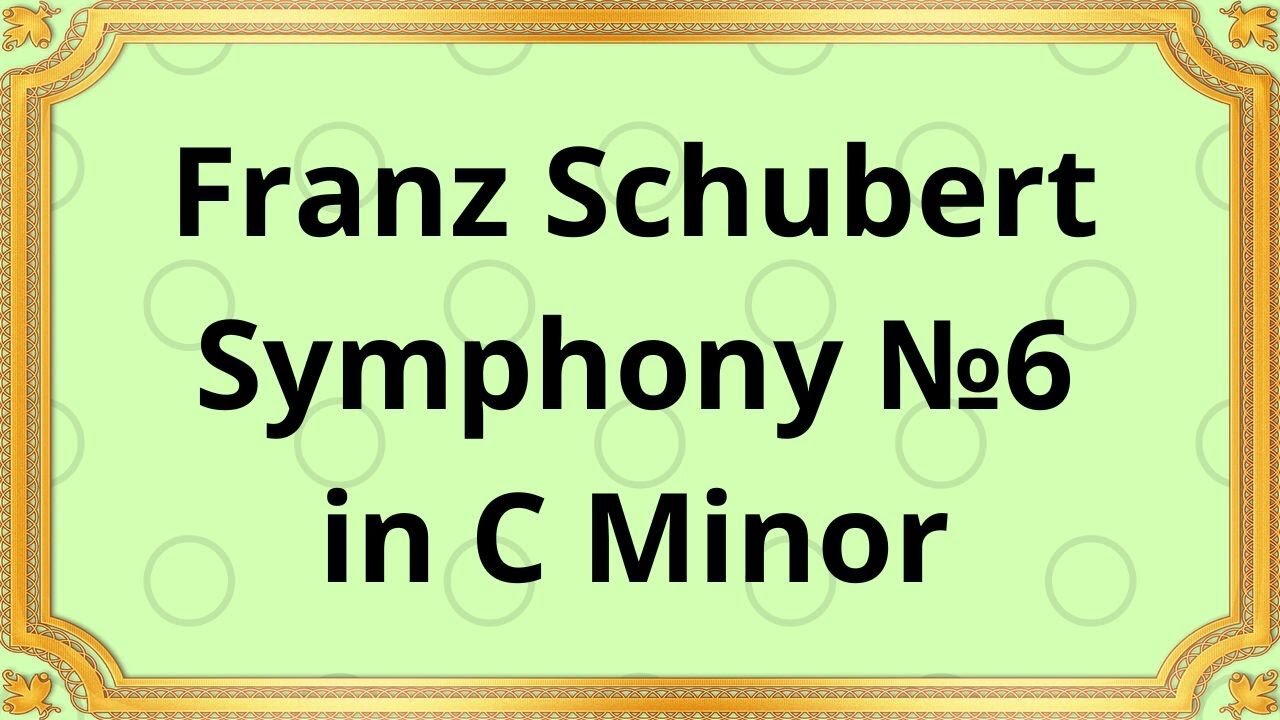Premium Only Content

Franz Schubert Symphony №6 in C Minor
#classicalmusic #FranzSchubert #SymphonyNo6 #Cminor #musicalcomposition #VienneseClassical #orchestralmusic #Romanticera #symphony #SchubertSymphony
Bavarian Radio Symphony Orchestra; Alphonse Dressel
Franz Schubert, a prominent Austrian composer of the Romantic era, created a treasure trove of musical compositions that have stood the test of time. One such masterpiece is his Symphony No. 6 in C Minor.
Franz Schubert composed his Symphony No. 6, also known as the "Little C Major Symphony," in 1817 when he was just 20 years old. It was a time when the symphonic form was dominated by the works of Beethoven, and Schubert's symphony emerged as a powerful testament to his own unique musical voice. Although it was not performed during Schubert's lifetime, it was rediscovered and premiered in 1828, a year after his death, by Felix Mendelssohn.
Musical Structure:
1. Allegro moderato: The symphony opens with a bold and dramatic introduction, setting the stage for the emotional journey that lies ahead. The main theme is presented, showcasing Schubert's gift for expressive melodies.
2. Andante: The second movement unfolds with a serene and lyrical melody, evoking a sense of tranquility and introspection. Schubert's use of delicate orchestration and harmonic richness adds depth and emotional resonance to this section.
3. Scherzo: The third movement bursts forth with energy and vitality, characterized by its lively and playful rhythm. The symphony's tempo quickens, showcasing Schubert's ability to seamlessly transition between contrasting moods and tempos.
4. Allegro moderato: The final movement returns to the symphony's opening theme, bringing the composition full circle. Schubert expertly weaves together various motifs, building tension and anticipation, before culminating in a triumphant and powerful conclusion.
Schubert's Symphony No. 6 in C Minor holds a significant place in the repertoire of classical music. Its harmonic richness, melodic beauty, and emotional depth have captivated audiences for centuries. The symphony's exploration of contrasting moods and its seamless transitions between sections showcase Schubert's mastery of musical storytelling.
Additionally, Symphony No. 6 serves as a bridge between the classical and romantic eras, foreshadowing the grandeur and emotional intensity that would characterize the symphonic works of composers such as Mendelssohn, Schumann, and Brahms.
Conclusion:
Franz Schubert's Symphony No. 6 in C Minor stands as a testament to the composer's prodigious talent and his contribution to the world of classical music. With its expressive melodies, masterful orchestration, and seamless transitions, this symphony continues to inspire and captivate audiences around the globe, reminding us of the enduring power of Schubert's musical genius.
You have the opportunity to support the channel:
https://destream.net/live/RadSiarAl/donate
https://www.buymeacoffee.com/6355radsiaral
-
 6:07
6:07
Classical music_Music Inspiration
1 month agoJoseph Haydn Piano Sonata in D Major, Hob. XVI:51
891 -
 44:26
44:26
The Rubin Report
3 hours ago'Real Time' Crowd Stunned by Bill Maher’s Unexpected Glaring Blind Spot
44.2K35 -
 1:45:31
1:45:31
Benny Johnson
3 hours agoDeep State PURGE: CIA Agents STRIPPED of Badges as Trump DISMANTLES Dept of Education | Dem CENSURED
79.6K77 -
 55:56
55:56
Grant Stinchfield
2 hours ago $0.91 earnedWhat Happened to the Mystery Drones? They Don't Just Disappear, or do They?
21.7K2 -
 DVR
DVR
Flyover Conservatives
13 hours agoThe Medical Industry’s Dark Secret—What They Don’t Want Pregnant Women to Know! - Dr. James Thorp | FOC Show
28.6K -
 1:01:32
1:01:32
Standpoint with Gabe Groisman
2 days agoThe War on Israel: Yair Netanyahu Tells All
28.9K5 -
 2:10:19
2:10:19
Steven Crowder
5 hours agoTrump Loves Dictators: Debunking the Left’s Latest Attack Strategy
384K249 -
 1:03:38
1:03:38
Timcast
4 hours agoTrump Eyes CRIMINAL CHARGES For USAID Staff For FRAUD, SCOTUS Under Fire Over Ruling On $2B Payments
78.2K48 -
 2:02:54
2:02:54
LFA TV
18 hours agoBYE, BYE OBAMA AND BLM! | LIVE FROM AMERICA 3.6.25 11AM
53.5K23 -
 2:02:20
2:02:20
Matt Kohrs
13 hours agoTime To Buy The Stock Market Dip?! || The MK Show
63.8K3